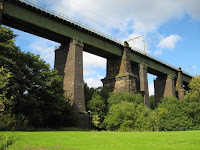A History of Glossop Railway Line & Beyond..
Part 4 of 6 - Dinting Arches
The remarkable structure is part and parcel of the Glossop skyline and has been for over a hundred years. To survive this long it has been modified in several ways and yet still maintains its historic
feel and look.
The viaduct was strengthened with new bearings installed along with repairs to the steel, brickwork and masonry, finished with a new lick of traditional olive green paint.
Dinting Arches originally formed part of “The Sheffield, Ashton-Under-Lyne and Manchester Railway”. The railway was opened from Manchester to as far as Godley in November 1841. The foundation stone of Best Hill Viaduct (Broadbottom) was laid by John Chapman Esq. on Thursday 17th February 1842. Then on the 10th December that same year trains ran from Godley to Broadbottom. It took a further two years to complete the Dinting Viaduct and the first train passed over on August 8th 1844.
There were originally sixteen arches; five of them were constructed of Baltic timbers each spanning 125 feet. The rest built of stone along with the stone pillars that exist today. The wooden arches stood 121 feet from the river bed.
 |
| The original wooden Dinting Arches |
A tremendous tragedy took place in the evening of 18th September 1855 when a train on a journey from Belle Vue stopped on the arches when three passengers stepped out and fell to their deaths.
The wooden arches needed to be strengthened in the 1850s with tie rods but this was not good enough so they were replaced by the wrought iron girders you can see today. Further strengthening took place in 1919 for the requirements after the First World War when heavier goods were imposed. The brick pillars were installed and some of the stone arches were filled in with bricks for added support. The entire works cost over £41,000 some 93 years ago.
 |
| The viaduct after 1919 |
The last major work was carried out in the 1950s in preparation for the electrification. The first electric train passed over in 1954. The recent update cost around £6.4 million pounds which was part funded and developed by Network Rail, now enabling the viaduct to last for many more years to come.
Matthew Cox

No comments:
Post a Comment